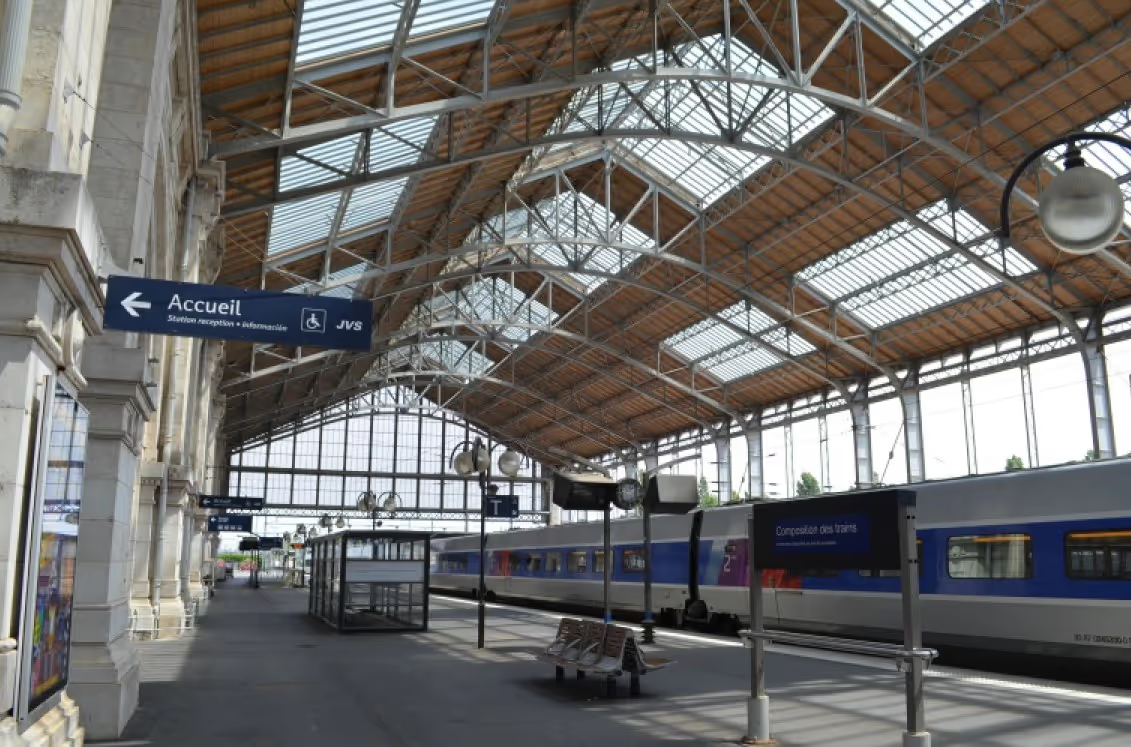Context and objectives of the project
The redevelopment of the multimodal transit hub at La Rochelle-Ville station was part of a broader effort to revitalize and reorganize the train station district. The aim of this project was to improve accessibility to the station and platforms, promote multimodal transportation, and transform the area into a dynamic new urban hub, all while reducing car traffic in the city centre. Transamo was to deliver a project plan that is in line with related redevelopment initiatives, technically and financially coherent, and well-integrated into the local urban environment. Transamo was responsible for configuring the governance structure of this multi-stakeholder project, overseeing studies and administrative procedures, providing technical expertise for the acquisition of engineering and architectural services, design studies for the new station footbridge, and MEP construction.
Challenges encountered
Technical
One of the main technical challenges of this project was designing a pedestrian and bicycle bridge spanning more than 100 metres in length. The bridge had to be built over several tracks, and meet height restrictions and safety requirements for railways, while managing unstable soil (swelling clay) and preventing water from rising during construction. This necessitated several geotechnical studies.
Environmental
The preservation of the nearby Tasdon marsh wetland, classified as ZNEIFF I (Natural Area of Ecological, Faunistic, and Floristic Interest) was a major priority. Transamo implemented the avoid, reduce, compensate approach, identified by the French government, to mitigate the negative environmental impact of this project. Measures included a four-season wildlife and plant survey, and a rainwater drainage system designed to feed into a retention basin.
Transamo’s mandates
Transamo provided support for the entire project, from defining the program to completing the work, using its Project Reference Framework tool. Tasks encompassed designing a governing structure, organizing the work schedule, supervising purchasing and legal matters, leading technological crews, directing research initiatives such as program enhancement, architectural contests, and task records. Transamo also handled regulatory processes like public hearings and authorizations. Additionally, Transamo provided specialized writing services, including technical descriptions, arrangements, and budgetary monitoring until completion.
Governance
The "Communité Urbaine" of La Rochelle was the contracting authority, operating within a multi-stakeholder framework established by a general agreement protocol. The project’s financial partners included the French State, the European Union, the Nouvelle-Aquitaine region, the Charente-Maritime department, the City of La Rochelle, SNCF Réseau, and SNCF Gares & Connections.
The redevelopment of MEP had a substantial positive impact on the urban development of area surronding the train station and the wider city. It promoted the use of public transportation by improving the efficiency of the public transport system and coordinating mobility services around a central, accessible multimodal hub.
Key figure
- 10 geotechnical surveys carried out to assess soil contamination risks.
- A footbridge or cycling path spanning 100 metres in length.
- 78 hectares of wetland (ZNIEFF I) covered by environmental studies.
Key takeaways
This project demonstrated the full range of Transamo’s skills in managing complex projects. Transamo was instrumental during the crucial phases of structuring gouvernance and timelines, refining the program, securing regulatory procedures, and overseeing design and construction.
Frequently asked questions (FAQ)
What is a L300-2 regulatory public consultation?
It is an optional, preliminary public consultation process regulated by the French Urban Planning Code. It pertains to specific projects requiring a construction or development permit. Throughout this stage, the proponent must provide information and solicit input from the community. The resulting feedback is summarized in a consultation report, which is subsequently submitted to the city council for consideration.
What is a “Project Reference Framework”, and how does it contribute to the success of a project?
The Project Reference Framework is a comprehensive guide for managing intricate, multi-stakeholder projects. The document compiles the program, master schedule, technical organization chart, governance structure, and risk analysis at the project’s inception. Once it is approved by the steering committees, it can centrally guide all stakeholders around concrete objectives for cost, time, and performance. It also functions as a benchmark for tracking progress and making prompt decisions in response to deviations.
What is a design competition for engineering and architecture services?
It is a process where a procurement entity outlines its goals for a project and invites multiple teams of architects and engineers to submit their ideas. A jury then evaluates these proposals and selects the winner, who is awarded a contract for professional services.



